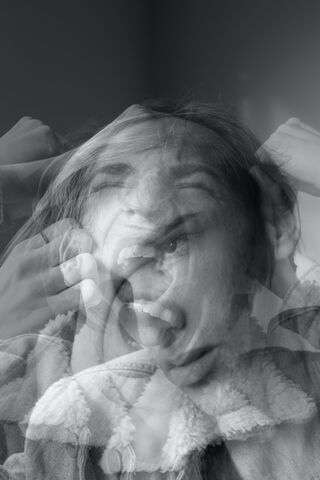Bias
Where Did Anorexia Stereotypes Come From?
Early links to hysteria have contributed to misconceptions about anorexia.
Posted April 30, 2022 Reviewed by Tyler Woods
Key points
- Anorexia was first considered a type of hysteria.
- Reformation in how we care for mental illness helped define anorexia as its own disorder.
- While many symptoms of anorexia don't have medical explanations yet, this doesn't mean they aren't real.
- Educating the public about medical explanations for anorexia could reduce its stigma.

Anorexia and Hysteria: A Shared History
Before modern medicine, unexplained women’s behaviors and illnesses were diagnosed as hysteria.1
Symptoms of hysteria included, but weren’t limited to, fever and physical pain, as well as behaviors that didn’t fit female stereotypes of passivity, feebleness, and fragility. Mood swings, anxiety, and depression were all considered symptoms of hysteria.2
Prior to the mid-1800s, anorexia wasn’t recognized as a medical condition and, therefore, cases of self-starvation were diagnosed as hysteria.1
Because hysteria symptoms were attributed to female-specific anatomy (e.g., the womb) and pregnancy, only women were diagnosed with it.2 This is partially why anorexia stereotypes (i.e., it’s a female illness) developed. It's also why many still think anorexia is "all in someone's head."
Separating Anorexia from Hysteria
Psychiatric asylums played a role in anorexia being recognized as its own medical condition separate from hysteria.1
Before the 1800s, people with psychiatric conditions were cared for by family. If the family was wealthy, they could also send people to a psychiatric institution for care.3
At first, psychiatric institutions were places where people with mental illnesses were looked after, but not necessarily treated. Consequently, patients staying in these institutions could suffer inhumane treatment, such as being tied to their beds.3

This changed in the 1800s with a mental health reformation. People began to see mental illness as either curable or at least manageable, through kindness and therapy. Consequently, psychiatric institutions began offering treatments and rehabilitation. They were also opened to the poor.3
With the reformation came accountability. Psychiatric asylums were required to submit public progress reports detailing what was happening in their institutions.3
This meant the public could see how many people were dying from self-starvation and it alarmed them. Why were people starving to death? It seemed like the institutions were being neglectful.1
This pushed doctors to examine cases of self-starvation further, eventually making it a recognized medical condition: anorexia nervosa.1
Physician Sir William Withey Gull is credited with scrapping the disorder’s initial name, l’anorexie hysterique (hysterical anorexia), and replacing it with anorexia nervosa. By swapping hysteria with nervosa, Gull was acknowledging the role of the nervous system and mind in the illness, while clarifying that both males and females could develop it.1
Modern Misconceptions about Anorexia
Since the mid-1800s, we’ve gained a deeper understanding of why anorexia develops. Nonetheless, its early associations with hysteria have been difficult to escape.

For example, a quote in a 1982 Life Magazine article claimed that “hysteria has almost disappeared, but if there is an equivalent today it is anorexia, the psychosomatic disorder of young, middle-class women who won’t eat.”4
While researchers in the 1980s largely agreed that anorexia and hysteria were not the same illness, a 1988 article from Harvard scientists still suggested both illnesses were caused by female cultural stereotypes.4
While female cultural stereotypes play a role in anorexia development, it’s misleading to suggest they solely cause it. Anorexia is not restricted to females and its development is complex.
Anorexia as a Psychosomatic Disorder?
Because we still don’t know exactly why anorexia develops, some modern researchers have suggested it is a psychosomatic condition.5
A psychosomatic disorder is a condition where observed physical symptoms don't have medical explanations.6 These symptoms are instead attributed to psychological things (e.g., stress, emotions, and personality).

This doesn’t mean psychosomatic conditions are imaginary or that they're all in someone’s head. Many times, we just haven’t found medical explanations for them yet. As science advances, the number of disorders considered purely psychosomatic shrinks. Stomach ulcers, for example, were once considered psychosomatic, but now have a medical explanation.6
While only a few disorders remain purely psychosomatic, many have psychosomatic contributors. Stress is an example of a psychosomatic contributor, as it can increase the likelihood of illness development. For example, we know that certain factors (e.g., genetics) make a person more susceptible to developing cardiovascular disease. Stress can increase the likelihood that these people will develop it.6
Certain psychosomatic contributors (e.g., emotions) can also increase the likelihood that someone will develop anorexia. However, because we are beginning to find medical explanations for why anorexia develops (particularly genetics and neurochemical dysfunction), we can’t call it a purely psychosomatic condition.
Medical Explanations for Psychosomatic Symptoms in Anorexia
Alexithymia and illness denial are two common psychosomatic symptoms of anorexia.5 While we haven’t established medical explanations for either symptom, we’re making progress.
Alexithymia is a personality trait that makes it difficult to identify our feelings, describe what other people are feeling, and to think imaginatively.7
Why alexithymia develops and how it contributes to physical symptoms in anorexia is unclear.
Some studies show that dysfunction in brain areas associated with understanding facial expressions might cause alexithymia (e.g., the dorsal anterior cingulate cortex).7 Another explanation is increased activation in brain regions involved in pain perception (e.g., the insula). This could be why people with alexithymia have low pain thresholds. Low levels of the neurochemical oxytocin might also cause alexythimia.8 Oxytocin helps us understand our emotions, as well as the emotions of others. This is something people with anorexia often struggle with. Consequently, it's unsurprising that people with anorexia tend to have atypical levels of oxytocin.9

Illness denial is more difficult to find a medical explanation for. Nonetheless, research has found that brain functioning might contribute to it. For example, some studies suggest that people with anorexia might have difficulty accurately determining their body size and shape.10 This would explain the denial of apparent weight loss. It’s unclear, though, if these are problems with size estimation accuracy (e.g., vision problems) or if the problem is how people with anorexia interpret what they see (e.g., emotional dysfunction).10
Either way, people with anorexia are not denying their illness out of stubbornness. There are emerging neurological explanations.
Conclusions
Despite slowly finding medical explanations for anorexia since the 1800s, misconceptions about its legitimacy as an illness remain.
Understanding why people develop anorexia is only part of the solution to changing these misconceptions. We also need to change how we discuss anorexia. We can do this by diversifying the stories we tell about it, such as including males, different genders, and adults in our conversations. Providing accessible information about medical explanations for anorexia to the public could also help reduce its stigma.
References
1)Jablonowski, J. (2018). From hysteria to anorexia nervosa: An evolution of medical terminology. Fugitive Leaves. Retrieved from: http://histmed.collegeofphysicians.org/from-hysteria-to-anorexia-nervos…
2)Tasca, C., et al. (2012). Women and hysteria in the history of mental health. Clinical Practice & Epidemiology in Mental Health, 8, 110-119.
3)Science Museum. (2018). A victorian mental asylum. Science Museum. Retrieved from: https://www.sciencemuseum.org.uk/objects-and-stories/medicine/victorian…
4)Bemporad, et al. (1988). Hysteria, anorexia, and the culture of self-denial. Psychiatry, 51, 96-103.
5)Abbate-Daga, G., et al. (2013). Psychosomatic syndromes and anorexia nervosa. BMC Psychiatry, 13.
6)Bransfield, R., & Friedman, K. (2019). Differentiating psychosomatic, somatopsychic, multisystem illnesses, and medical uncertainty. Healthcare, 7.
7)Kano, M., & Fukudo, S. (2013). The alexithymic brain: The neural pathways linking alexithymia to physical disorders. Biopsychosocial Medicine, 7.
8)Schmelkin, C., et al. (2017). Lox oxytocin levels are related to alexithymia in anorexia nervosa. International Journal of Eating Disorders, 50, 1332-1338.
9)Kim, Y., et al. (2014). The impact of intranasal oxytocin on attention to social emotional stimuli in patients with anorexia nervosa: A double blind within-subject cross-over experiment. PLOS One, 9.
10)Madsen, S., Et al. (2013). Visual processing in anorexia nervosa and body dysmorphic disorder: Similarities, differences, and future research directions. Journal of Psychiatric Research, 47, 1483-1491.




